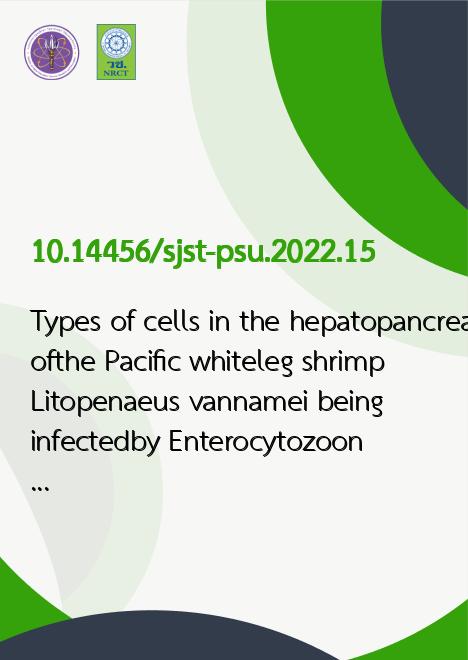
|
Types of cells in the hepatopancreas ofthe Pacific whiteleg shrimp Litopenaeus vannamei being infectedby Enterocytozoon hepatopenaei |
|---|---|
| รหัสดีโอไอ | |
| Creator | 1. Niroyhannah Nima 2. Pornsawan Duangsuwan 3. Pattira Pongtippatee 4. Daungkhaetita Kanjanasopa 5. Boonsirm Withyachumnarnkul |
| Title | Types of cells in the hepatopancreas ofthe Pacific whiteleg shrimp Litopenaeus vannamei being infectedby Enterocytozoon hepatopenaei |
| Publisher | Research and Development Office, Prince of Songkla University |
| Publication Year | 2565 |
| Journal Title | Songklanakarin Journal of Science an Technology (SJST) |
| Journal Vol. | 44 |
| Journal No. | 1 |
| Page no. | 97-102 |
| Keyword | growth retardation, white-feces disease, shrimp culture, Enterocytozoon hepatopenaei, Microsporidia |
| URL Website | https://rdo.psu.ac.th/sjst/index.php |
| ISSN | 0125-3395 |
| Abstract | Enterocytozoon hepatopenaei (EHP), the fungus-related micro-organism that infects the hepatopancreas of marineshrimp, is believed to cause growth retardation of the infected shrimp. As the hepatopancreatic cells are composed of differentcell types that support the digestive system and innate defense, malfunction of the infected cells could lead to growth retardationand weakness. This study aimed to determine of the percentage of each hepatopancreatic cell type infected by EHP and itsinfectious levels in the normal and growth-retarded Pacific whiteleg shrimp Litopenaeus vannamei. Histological examinationrevealed that all the cell types examined were infected with EHP, with significantly higher (p<0.01) percentage on the M- and Fcells, compared to other cell types. The R-, B- and F-cells of the growth-retarded shrimp were infected at significantly lower(p<0.05) percentage than the same cell types of the normal shrimp. By PCR, positive reactions of EHP infection were detected inall shrimp samples, both in the normal and growth-retarded shrimp, but only at the nested PCR level. Also, the relative density ofthe EHP load in the hepatopancreas of the two shrimp groups did not differ statistically. These results suggest that growthretardation in L. vannamei currently exists may not be due to EHP infection. |
